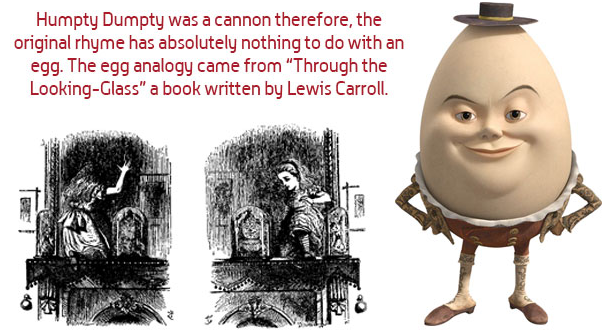

The term also was an 18th-century bit of slang for a short and clumsy person. Later, other versions popped up, though they didn’t have as long a shelf-life, if you will, as the more commonly known versions today.Īccording to the Oxford English Dictionary, in the 17th century, the term “humpty dumpty” referred to a drink made of brandy boiled with ale. Those lyrics go:Ĭould not make Humpty Dumpty where he was before.įurther, in 1810 a different version was recorded with slightly different wording and meaning:Ĭannot place Humpty dumpty as he was before. However, the earliest version of the rhyme comes from 1797 and looks and sounds much different compared to the more commonly known version and meaning today. Title: The Origin of Life, the Humpty-Dumpty Effect, & God When: March 30 at 8:00pm Where: MSC 2406 Tickets: N/A, its free About the Talk: Why dont. The melody commonly associated with the rhyme was first recorded by composer and nursery rhyme collector, James William Elliott. The Humpty Dumpty nursery rhyme is also said to be derived from a brandy and ale drink from the 17th century, called a Humpty Dumpty. Today, the nursery rhyme is delivered as a single “quatrain,” or four-line effort, which follows the AABB rhyme scheme. And author James Joyce used Humpty as a metaphor for the fall of man in the novel Finnegans Wake. Free on Kodaly Downloads This is a great song for students to experience beat in a 6/8 time signature. Not only was Humpty not an egg, but according to many historians, he was likely a military cannon.

In that book, Humpty Dumpty was described as an egg. 'Humpty Dumpty' is a classic nursery rhyme. Who Is the Real Humpty Dumpty Since the original nursery rhyme was created over 50 years before Through the Looking-Glass, it could not have been the egg that was the inspiration behind it. In 1871, Humpty Dumpty was referred to in Lewis Carroll’s 1871 book, Through the Looking-Glass, which was a sequel to Alice in Wonderland. Fox in the pantomime musical of the same name, which ran from 1868 to 1869 with a total of nearly 500 performances. Humpty Dumpty was not a person at all, but a massive siege cannon that was used by Royalist forces (the kings men) during the English Civil War that raged. In the United States, the story was made popular by the Broadway actor George L. The first recorded version of the rhyme dates back to 1797 and the song was written in 1870 in James William Elliot’s book, National Nursery Rhymes and Nursery Songs. The song, which has origins in England, most likely began as a riddle. The main character of the little song, or nursery rhyme, is an egg named Humpty Dumpty.


 0 kommentar(er)
0 kommentar(er)
